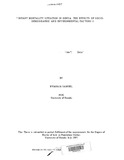| dc.description.abstract | This study set out to the relative effects of socio-demographic and environmental factors
on infant mortality in Kenya. The study adopted the Mosley and Chen's analytical
- framework for the study of child survival in developing countries. The data used in this
study came from Kenya Demographic and Health Survey (KDHS) of 1993. Two methods
of analysis were employed in this study - Trussel's technique of estimating child mortality
and logistic regression analysis. The first technique was used to estimate mortality levels
and probabilities of dying. The second method was used to assess the effects of socio-
demographic and environmental factors.
The results of the analysis revealed that: between 1985 and 1990 there was a sharp
decline in mortality and a light increase between 1991 and 1993; and that maternal level
of education, breastfeeding and source of water are the key factors influencing the
mortality risk during childhood. Maternal education was found to be the most crucial
socio-economic factor influencing infant mortality in Kenya. The study findings show that
children born to educated mothers had higher chances of survival compared to those born
to uneducated mothers, whereby the risk death before age 5 was on the average more than
twice as much for children whose mothers had no education when compared with those
whose mothers had secondary level of education.
Breast feeding and preceding birth interval were the most significant demographicfactors int1uencing the risk of death during infancy. Infants that were breastfed for longer durations had very low risks of death compared to those breastted for shorter durations. On the same note infants born with wider preceding birth intervals also had higher chances of survival compared to those with shorter preceding birth intervals. Source of drinking water and type of toilet facility were very significant environmental factors determining infant mortality. Use of bush, pit latrines and un-piped water increase the risk of infant death. For every 1000 infants from households which had no piped water and were using pit latrines, 137 were expected to die, while those from households with piped water, only 63 per 1000 were expected to die.
The study recommends that maternal education should be a priority in policy formulation and programme designs. Basic education programmes should therefore be expanded to reach majority of female population. Breastfeeding programmes should also be encouraged as part of the child survival programmes. Policies and programmes on environmental health need to be re-formulated to guarantee higher environmental health
standards so as to reduce the risk of infant deaths . | en |

